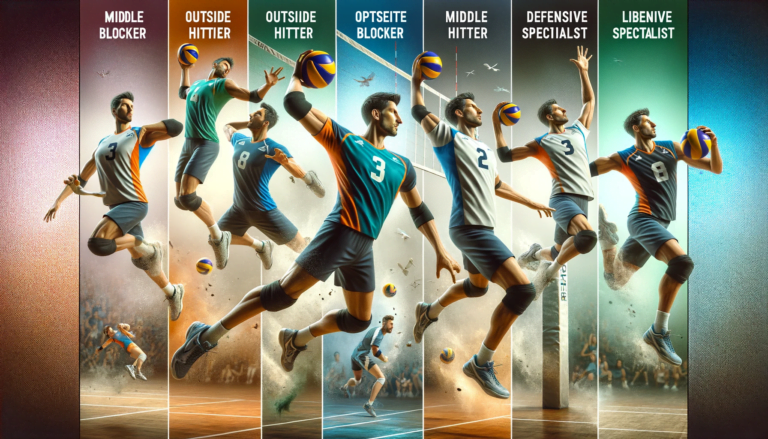Are Volleyball Shoes the Same as Badminton Shoes?
Introduction
You find yourself in a sports store and are astounded by the endless rows of athletic shoes. You’ve got a volleyball game tonight and a badminton match tomorrow. The million-dollar question pops into your head: “Can one pair of shoes cover both sports?” It’s like choosing between chocolate and vanilla when you really want a swirl!
Thesis Statement
Are volleyball and badminton shoes the same? Drumroll, please… They’re not! They may seem same, yet each has attributes tailored to its sport.

Brief Overview
We’ll explore volleyball and badminton shoes’ distinctive traits in a quick tour. We’ll examine their cushioning, grip, and real-world perspectives. You’ll be an educated consumer and your friends’ shoe expert by the end.
Setting the Stage
Brief History of Volleyball Shoes
Ah, the good ol’ days when volleyball shoes were just modified versions of basketball shoes. Seriously, it was like wearing a pair of tanks on your feet. Heavy and clunky? You bet. But then, voilà! Brands like Mizuno and Nike came along. They introduced lighter materials, better grip, and—wait for it—shoes that actually let your feet breathe. Revolutionary, right?
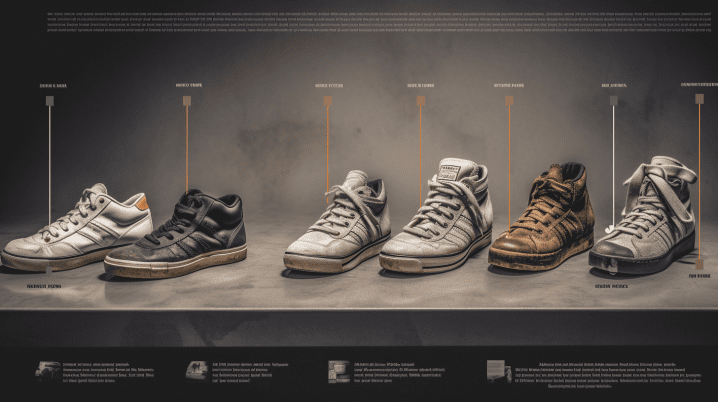
Brief History of Badminton Shoes
Now, let’s jump over to badminton, the sport where quick reflexes are the name of the game. Once upon a time, badminton shoes were basically glorified sneakers. But then, brands like Yonex and Asics said, “Hold my shuttlecock!” and started crafting shoes with mind-blowing grip and feather-light materials. Suddenly, it wasn’t just about the racket skills; your feet became magic wands too!
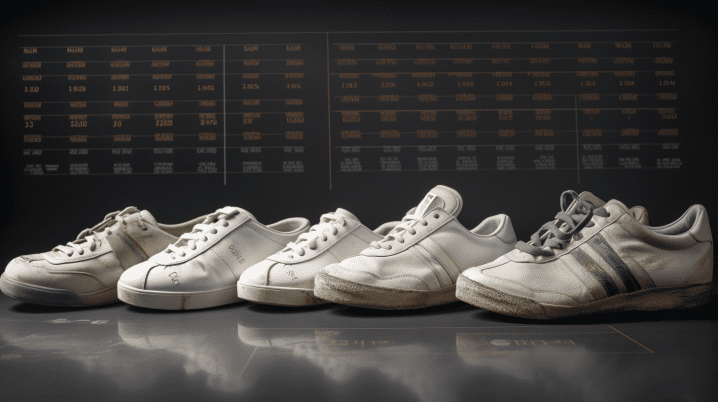
Why the Confusion?
Why do people confuse volleyball and badminton shoes? First off, they look alike. They shout “I’m built for speed!” with their low cuts and lightweight materials. The catch: they appear like long-lost twins but have different personalities and looks. Being confused with Superman and Spider-Man because they both wear spandex. Both have battlefield-specific super-skills, or court-specific talents.
There you go! A quick trip down memory lane and a dash of clarity on why volleyball and badminton shoes are often mixed up Think of them as siblings; they share some family traits but have their own unique quirks and features. So the next time you’re in that sports store, you’ll know your Asics from your Nikes and your volleyball from your badminton. Onward, to more shoe wisdom!
Volleyball Shoes – An Overview
Components and Design
You believe all sporting shoes are equal? Think again! Volleyball shoes distinguish out for their top, midsole, and outsole.
Upper
The top of the shoe holds your foot. It cushions your feet and stabilizes you during high-flying spikes.
Midsole
Ah, the cushiony middle! This is where the magic happens in terms of support and shock absorption. It’s like having a personal trampoline under each foot.
Outsole
This is the rubbery bottom part that makes friends with the court floor. Its best buddy? Grip! You don’t want to be sliding around like you’re on an ice rink, do you?
Popular Brands
Now, let’s talk about the big players in the volleyball shoe game: Nike, Adidas, and Mizuno.
Nike
These guys are like the Beyoncé of volleyball shoes. Stylish, high-performance, and oh-so-coveted.
Adidas
Consider them your loyal buddy. They function well and are affordable.
Mizuno
Dark horse, but don’t underestimate them. Smart, specialized, and always ready for a challenge, they’re volleyball shoes’ Hermione Granger.
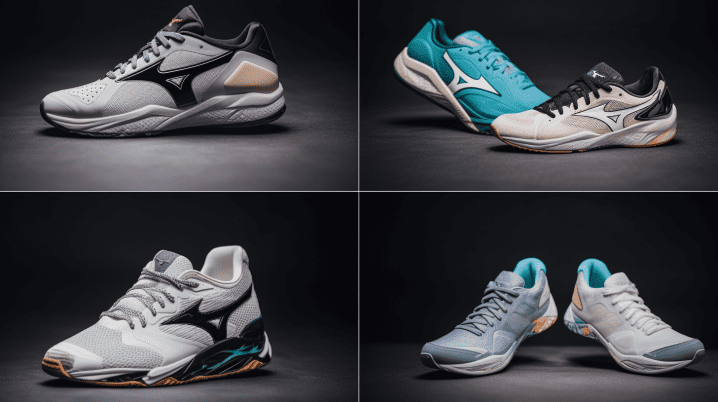
How They Affect Performance
Alright, time for the juicy part. How do these shoes actually affect your game? Let’s break it down.
Jumps
Those cushioned midsoles? They’re your secret weapon for higher and softer landings. It’s like having mini rockets in your soles!
Sprints
The lightweight upper doesn’t just hold your foot; it propels you forward like a race car revving up.
Lateral Movements
Ah, the side-to-side hustle. That’s where the grip of your outsole comes in. You’ll be zigzagging past opponents like a pro dodgeball player.
So there you have it; a quick yet in-depth overview of what makes volleyball shoes the unsung heroes of your game. From their meticulously designed components to the popular brands that athletes swear by, these shoes are more than just foot coverings. They’re performance enhancers, ready to help you in the volleyball court. So the next time you’re shopping for a pair, you’ll be armed with all the know-how to make the perfect pick.
Badminton Shoes – An Overview
Components and Design
Hold onto your shuttlecocks, because badminton shoes are a world unto themselves. Let’s talk about the three biggies that make them a must-have: grip, cushioning, and flexibility.
Grip
Imagine being a ninja on the court, making quick turns and sudden stops. That’s what a good grip offers you. You could say these shoes really “stick” to their job!
Cushioning
Jumping to smash that shuttlecock? You’ll want to land on a cloud, and that’s what the cushioning is for. It’s like having mini airbags for your feet.
Flexibility
Badminton involves a lot of quick, angular movements. Flexibility ensures your shoes can twist and turn just as fast as you do, sort of like a gymnast on the floor.
Popular Brands
When it comes to brands, we’ve got a few celebs in the badminton shoe world: Yonex, Li Ning, and Asics.
Yonex
These are the Michael Jordans of badminton shoes. Need I say more? They’re the go-to choice for many pros and offer top-notch performance.
Li Ning
If Yonex is the seasoned star, Li Ning is the up-and-comer with a lot to prove. They’re robust and often come with a more wallet-friendly price tag.
Asics
These are like the wise old wizards of athletic shoes. They bring years of shoe-making expertise to the badminton court, ensuring you’ve got both comfort and performance.
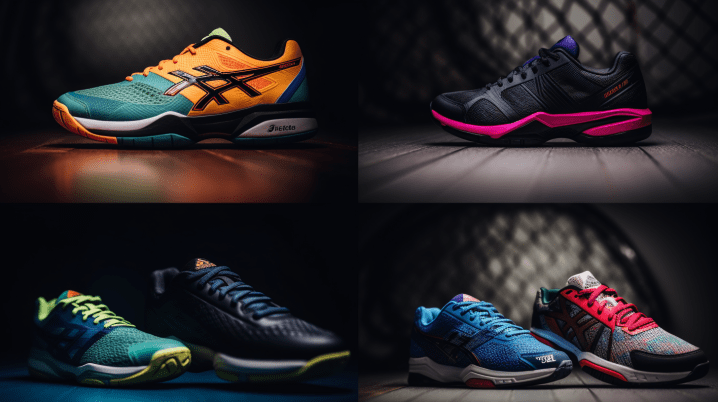
How They Affect Performance
Get to the point. How can shoes make you a badminton star?
Quick Footwork
Thanks to their excellent grip and flexibility, these shoes are like dance partners for your feet. They make quick footwork not just possible but effortless.
Agility
The lightweight design and cushioning mean you can move like a jaguar—fast and agile, ready to pounce on that shuttlecock at any moment.
Grip
Ever tried running on a slippery floor in socks? Not fun, right? A good grip is crucial for stability, ensuring you can make those rapid directional changes without taking a nosedive.
The Science Behind the Shoes
Material Considerations
Let’s nerd out over these shoes’ materials. Fairy dust and unicorn hair aren’t everything.
Synthetic Leather
This is the most common material you’ll find. It’s durable and offers good support. Think of it as the Swiss Army knife of shoe materials.
Mesh
Ah, the breathability factor! Mesh is like that cool breeze on a hot summer day for your feet. Plus, it makes the shoe lighter.
Rubber
Typically used for the outsole, rubber is what gives you that grip. It’s like having Spider-Man’s wall-crawling abilities, but for the court.
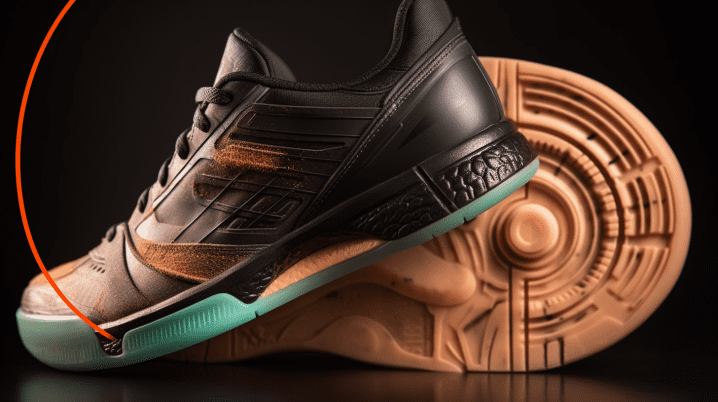
Foot Mechanics
Now, let’s talk about the ‘sole’ of the matter—foot mechanics! Not all feet are created equal, so it’s crucial to understand some basics.
Foot Arches
Some people have high arches, some have flat feet, and others are in between. The midsole of your shoe needs to match your arch type, sort of like finding your soulmate.
Pronation and Supination
Fancy words, right? Pronation is when your foot rolls inward, and supination is the opposite. Knowing which one you do can help you pick the right shoe to balance things out.
Surface Interactions
The last topic is how your shoes interact with various surfaces. It ends happily like a romantic tale.
Hardwood Floors
These are most common in volleyball. You’ll need a shoe with excellent grip and cushioning, sort of like a mountain climber needs good ropes and boots.
Synthetic Mats
Badminton courts use them, which need a different grip. The focus is on elegance, not power.
Head-to-Head Comparison
Price Range
Let’s talk money, honey! After all, we all want to get the most bang for our buck, right?
Volleyball Shoes
Generally speaking, you could snag a decent pair for around $60 to $130. Think of it as the price of a nice dinner date, but the love affair with these shoes will last a lot longer!
Badminton Shoes
You should expect to pay $40 – $120 or more. You may fill up on both fast food and gourmet dinners, but the latter offers a more satisfying experience.

Feature-by-Feature Breakdown
Let’s get down to business. Let’s compare these sneakers feature-by-feature.
Cushioning
Volleyball shoes typically have more cushioning to deal with the high jumps and heavy landings. Badminton shoes, on the other hand, have just enough to provide comfort without sacrificing speed.
Grip
The grip of badminton shoes promotes rapid, dynamic movements. Volleyball shoes provide a better grip for speed and control.
Design
More ankle padding and thicker soles are common in volleyball shoes. Badminton shoes are sleeker for rapid footwork.
Volleyball Shoes Pros & Cons
Let’s consider the benefits and downsides as judges.
Pros
Durable construction, balanced grip, and excellent cushioning.
Cons
Might slow you down during lengthy play due to its weight.

Badminton Shoes Pros & Cons
Pros
Lightweight, excellent grip for quick lateral movements, and generally more breathable.
Cons
Less cushioning could mean more stress on your feet during long matches.
Final Recommendations
For Beginners
If you’re new at volleyball or badminton, “Which shoe should I start with?” No worries; we’ve got you.
Volleyball
For beginners in volleyball, choose a shoe with cushioning and ankle support. Keep your ankles safe and comfortable—you won’t be performing Olympic leaps yet.
Badminton
Newbies in badminton should prioritize grip and lightness. You’ll be making a lot of quick, small movements, so you want a shoe that can keep up without making your feet feel like they’re encased in cement.
For Intermediate and Advanced Players
You seasoned athletes, listen up! Your shoe needs are a bit more nuanced.
Volleyball
As you move up the ranks, you’ll want a shoe with exceptional durability and specialized cushioning. You’re likely to play longer and jump higher, so make sure your shoes can take the heat.
Badminton
For advanced players, look for something with excellent grip but also added cushioning. Your rallies are longer and your jumps higher, so you’ll need that extra bit of support.

Overall Best Choice
Let the cheers begin… Which shoe do you think will win? Why? Not so easy.
Volleyball vs. Badminton
Every shoe has perks and downsides specific to each sport. For high leaps and unexpected landings, volleyball shoes provide cushioning and support. Badminton shoes are grippable and agile for fast footwork and lateral motions.
Thus, the perfect shoe relies on your playing goals. For lethal spikes and blocks, volleyball shoes are perfect. For fast rallies and nimble footwork, use badminton shoes.
Conclusion
Summarizing the Key Takeaways
Okay, let’s finish. We examined volleyball and badminton shoes’ materials and foot mechanics. We balanced the positives and negatives with a side-by-side comparison.
Restate the Answer to the Main Question
Returning to “Are volleyball shoes badminton shoes?” The answer was no. Despite seeming like long-lost brothers, each shoe improves athletic performance.
Volleyball shoes are cushioned, supportive, and durable. Their design lets you jump higher, land gently, and stay stable in rapid games. Badminton shoes boost grip and agility. They improve court speed and agility, allowing fast footwork and unexpected direction changes.
Your sport determines the “best” shoe. A spike-loving volleyball player? Do you hover on the badminton court like a hummingbird? Knowing what you want makes shoe shopping simple.
Finished! We covered volleyball and badminton shoes, so hopefully you’re out with the right shoes and information. Enjoy playing!

Frequently Asked Questions
Can you wear badminton shoes to play volleyball?
While you technically could wear badminton shoes to play volleyball, it’s not recommended. Badminton shoes focus on grip and agility, but they often lack the cushioning and ankle support needed for volleyball’s high jumps and sudden landings. It’s like using a butter knife to cut a steak; it works, but not very well.
What’s the difference between badminton shoes and volleyball shoes?
The main difference lies in the design focus. Volleyball shoes emphasize cushioning and ankle support for jumps and landings, while badminton shoes prioritize grip and agility for quick footwork. It’s akin to comparing a sprinter to a long-distance runner—both are athletes, but they have different needs.
Can I use Yonex shoes for volleyball?
Yonex specializes in badminton shoes, which means they are designed for grip and agility, not for the cushioning required in volleyball. While you might manage, you’ll likely find them lacking in support and shock absorption. It’s like using a golf ball in a soccer match; it’s just not the right fit.
What shoes to wear for badminton?
For badminton, opt for specialized badminton shoes from trusted brands like Yonex, Asics, or Li Ning. These shoes offer the grip and agility you’ll need for those quick lateral movements, almost like having dance shoes for the court.
Can any shoes be volleyball shoes?
Technically, you could wear any athletic shoes to play volleyball, but it’s not advisable. Volleyball shoes are specially designed for the sport’s unique demands, like cushioning for jumps and support for lateral movements. Using regular shoes is like trying to paint a mural with a toothbrush; you need the right tools for the job.
What shoes are appropriate for volleyball?
Volleyball-appropriate shoes should offer good cushioning, ankle support, and grip. Brands like Mizuno, Adidas, and Nike offer specialized volleyball shoes that are engineered to meet these specific needs. Think of it as buying hiking boots for a mountain trek; you want the right gear for the activity.
Why are badminton shoes so expensive?
Badminton shoes can be pricey due to the specialized technology and materials used for optimal performance. They often incorporate features like enhanced grip, lightweight materials, and specialized cushioning. It’s a case of “you get what you pay for.”
Can I run with badminton shoes?
Running in badminton shoes is not recommended. These shoes are designed for grip and lateral movement on the court, not for the forward motion and impact absorption needed for running. It’s like trying to ski in snowboarding boots; it’s just not the right equipment.
Is it OK to use basketball shoes for badminton?
Basketball shoes may offer some of the ankle support needed for badminton, but they generally lack the grip and lightweight design needed for quick, agile movements in badminton. They’re built for a different type of court action.
Can I wear Converse for badminton?
Converse shoes lack the grip, cushioning, and support needed for badminton. While they’re stylish and great for casual wear, they’re not engineered for the rapid, multidirectional movements of badminton. It’s like wearing flip-flops to a formal event; it just doesn’t work.
What are badminton shoes like?
Badminton shoes are generally lightweight, offer excellent grip, and come with just enough cushioning for comfort. They’re built for agility and quick lateral movements, almost like they’re designed to make you a court ninja.
Should I wear socks with badminton shoes?
Absolutely, socks can provide additional comfort and help to prevent blisters. They act as a cushion and sweat absorber, making your time on the court more enjoyable. It’s like having a comfy liner inside your favorite pair of boots.
Why are volleyball shoes better?
Volleyball shoes are “better” in the context of what they’re designed for: providing support, cushioning, and durability needed for the sport’s specific movements, like jumping and quick lateral shifts. It’s the difference between having a specialized tool versus a one-size-fits-all gadget.
Can I wear Adidas for volleyball?
Yes, Adidas offers specialized volleyball shoes designed with the sport’s needs in mind. They offer a good blend of cushioning, support, and durability. It’s like having a Swiss Army knife specifically designed for volleyball.
Are volleyball shoes lightweight?
Compared to other athletic shoes, volleyball shoes are relatively lightweight but offer enough heft to provide the necessary support and cushioning. They’re like the middle ground between a heavy boot and a light slipper, tailored for the sport.
What can replace volleyball shoes?
In a pinch, basketball shoes can serve as a temporary replacement due to their cushioning and ankle support. However, they won’t offer the same level of performance as specialized volleyball shoes. It’s like using a sedan for off-roading; it can work, but it’s not ideal.
What shoes are not good for volleyball?
Running shoes or casual sneakers are not recommended for volleyball. They lack the required grip, cushioning, and ankle support. It’s like using a fishing rod to play golf; you’ll be at a disadvantage.
Can I wear Converse to volleyball?
Converse shoes are not suitable for volleyball as they lack the essential features like cushioning and ankle support. It would be like using a skateboard for mountain biking; you’re asking for trouble.
Why is ASICS good for volleyball?
ASICS offers a range of volleyball shoes designed with advanced technologies for grip, cushioning, and support. They’re like the Rolls Royce of volleyball footwear, offering a luxurious and high-performance experience.
Are sneakers good for volleyball?
Standard sneakers are not ideal for volleyball because they lack the sport-specific features like enhanced grip and specialized cushioning. It’s like using a calculator to send a text message; wrong tool for the job.
Do volleyball shoes break in?
Yes, like most athletic shoes, volleyball shoes will break in and become more comfortable over time. However, they’re generally designed to be comfortable right out of the box. It’s like a good leather jacket; it only gets better with time
What type of shoe is best for indoor volleyball?
For indoor volleyball, look for shoes with a gum rubber sole for optimal grip, along with good cushioning and ankle support. It’s like choosing winter tires for snowy conditions; specialization matters.
Can I wear Nike pros for volleyball?
Nike offers professional-grade volleyball shoes that provide the necessary cushioning, support, and grip needed for the sport. So yes, Nike Pros would be a suitable choice, like picking a DSLR camera for professional photography.
Can you wear volleyball shoes as everyday shoes?
While you could, volleyball shoes are optimized for court performance and may wear out quickly on regular terrain. It’s like using a race car for your daily commute; not the most practical choice.
Why are volleyball shoes expensive?
Volleyball shoes can be costly due to the specialized technology and materials used for optimal court performance. You’re paying for the research and development that goes into making them as efficient as possible, just like buying a high-end computer.
Can volleyball shoes make you jump higher?
Specific indoor volleyball shoes are best, as general indoor shoes may lack the necessary grip and cushioning. It’s like using indoor soccer shoes for a basketball game; you’ll be missing key features.
How many inches do volleyball shoes add?
Volleyball shoes don’t add significant height, maybe an inch at most, due to their cushioning. They’re designed for performance, not height enhancement.
What shoe increases your vertical the most?
No shoe can significantly increase your vertical jump; that comes from training and technique. Shoes can only assist by providing the right support and cushioning.
What is the fastest way to increase your vertical jump for volleyball?
Improving your vertical jump involves a combination of strength training, plyometrics, and proper technique. Shoes can provide support, but the real gains come from focused training.


